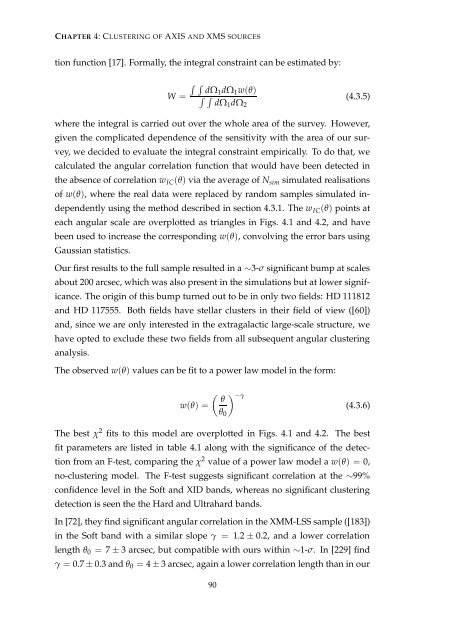pdf - SRON
pdf - SRON
pdf - SRON
Create successful ePaper yourself
Turn your PDF publications into a flip-book with our unique Google optimized e-Paper software.
CHAPTER 4: CLUSTERING OF AXIS AND XMS SOURCES<br />
tion function [17]. Formally, the integral constraint can be estimated by:<br />
W =<br />
∫ ∫<br />
dΩ1 dΩ 1 w(θ)<br />
∫ ∫<br />
dΩ1 dΩ 2<br />
(4.3.5)<br />
where the integral is carried out over the whole area of the survey. However,<br />
given the complicated dependence of the sensitivity with the area of our survey,<br />
we decided to evaluate the integral constraint empirically. To do that, we<br />
calculated the angular correlation function that would have been detected in<br />
the absence of correlation w IC (θ) via the average of N sim simulated realisations<br />
of w(θ), where the real data were replaced by random samples simulated independently<br />
using the method described in section 4.3.1. The w IC (θ) points at<br />
each angular scale are overplotted as triangles in Figs. 4.1 and 4.2, and have<br />
been used to increase the corresponding w(θ), convolving the error bars using<br />
Gaussian statistics.<br />
Our first results to the full sample resulted in a ∼3-σ significant bump at scales<br />
about 200 arcsec, which was also present in the simulations but at lower significance.<br />
The origin of this bump turned out to be in only two fields: HD 111812<br />
and HD 117555. Both fields have stellar clusters in their field of view ([60])<br />
and, since we are only interested in the extragalactic large-scale structure, we<br />
have opted to exclude these two fields from all subsequent angular clustering<br />
analysis.<br />
The observed w(θ) values can be fit to a power law model in the form:<br />
w(θ) =<br />
( θ<br />
θ 0<br />
) −γ<br />
(4.3.6)<br />
The best χ 2 fits to this model are overplotted in Figs. 4.1 and 4.2. The best<br />
fit parameters are listed in table 4.1 along with the significance of the detection<br />
from an F-test, comparing the χ 2 value of a power law model a w(θ) = 0,<br />
no-clustering model. The F-test suggests significant correlation at the ∼99%<br />
confidence level in the Soft and XID bands, whereas no significant clustering<br />
detection is seen the the Hard and Ultrahard bands.<br />
In [72], they find significant angular correlation in the XMM-LSS sample ([183])<br />
in the Soft band with a similar slope γ = 1.2 ± 0.2, and a lower correlation<br />
length θ 0 = 7 ± 3 arcsec, but compatible with ours within ∼1-σ. In [229] find<br />
γ = 0.7 ± 0.3 and θ 0 = 4 ± 3 arcsec, again a lower correlation length than in our<br />
90
















